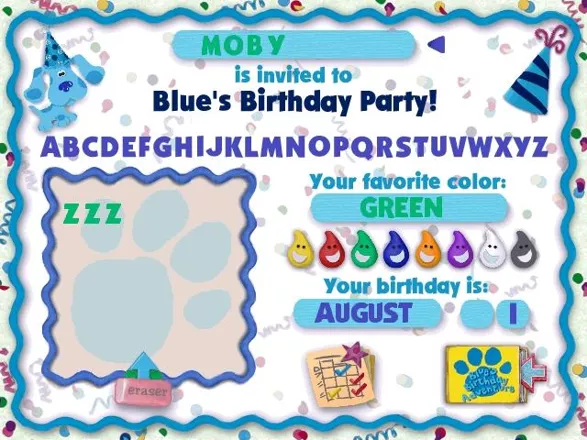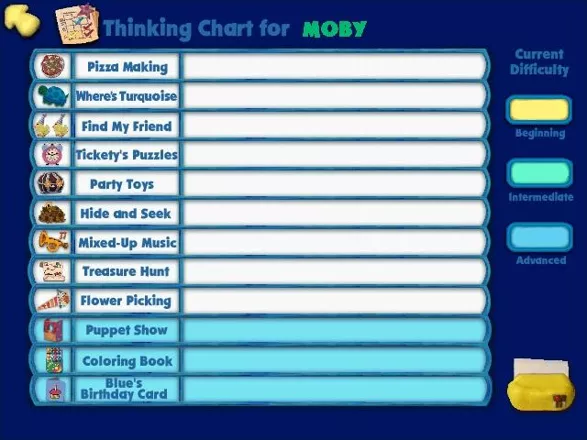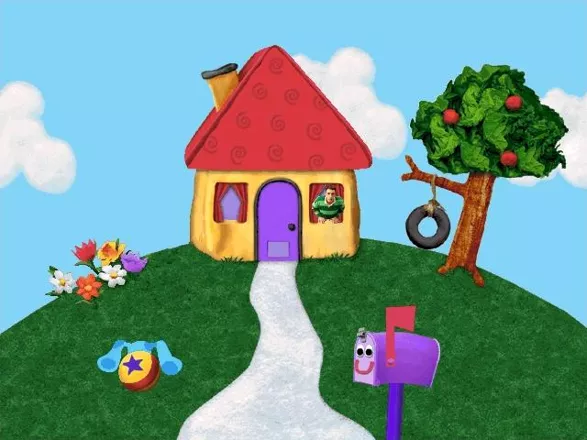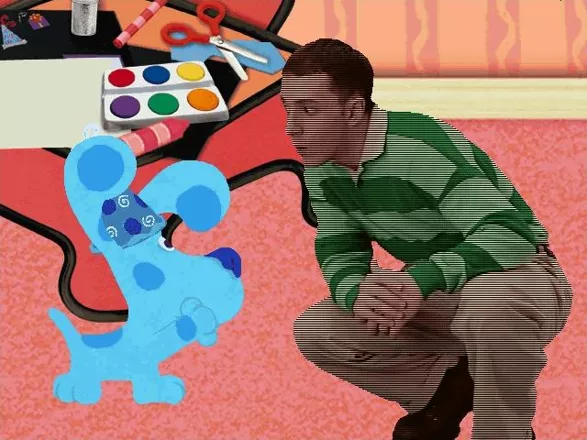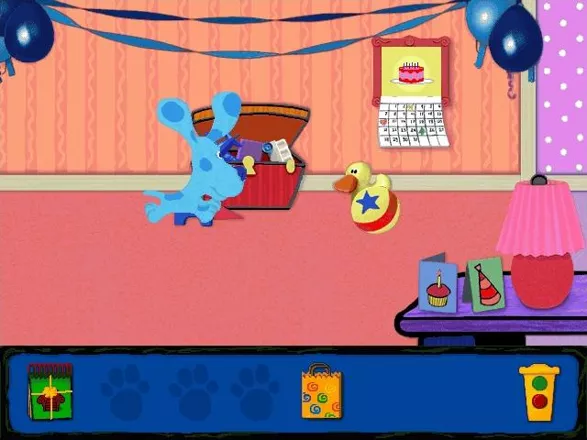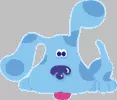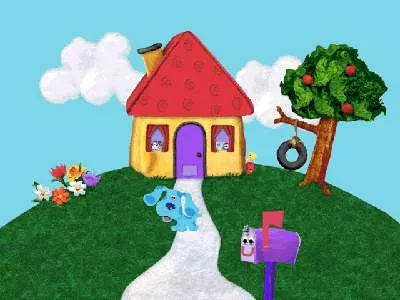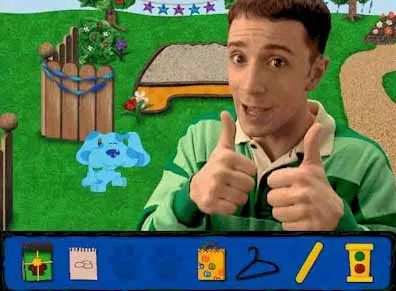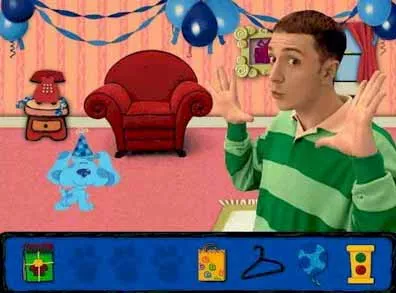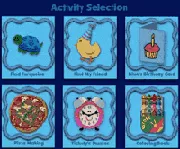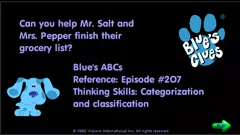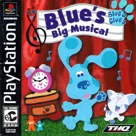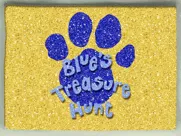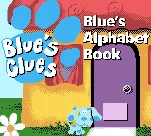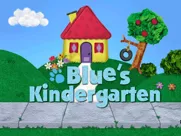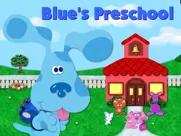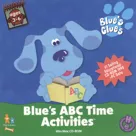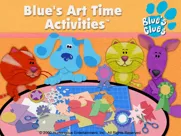Blue's Clues: Blue's Birthday Adventure
Description
In Blue's Clues: Blue's Birthday Adventure, spotted puppy Blue and her human friend Steve prepare for Blue's birthday party. Four questions are posed to the player: What does Blue want to do at her party? What does Blue want to play at her party? What does Blue want to give her guests at her party? What does Blue want to eat at her party? As in the Blue's Clues television show that the characters are based on and in Blue's Treasure Hunt, each question can be solved by discovering "clues" indicated by blue paw prints. As each set of three clues is collected, Steve retires to his thinking chair to ponder the clues, and the player must select the most likely combination from a group of three pictures. The player's reward is the party itself with a special activity dictated by the question that was solved.
There are two discs, each one covering two questions, or pathways - each pathway is a complete game, and can be played independently of the others, in any order. There are nine directed activities in the game:
- Find My Friend
- Tickety's Puzzles
- Pizza Making
- Flower Picking
- Party Toys
- Hide and Seek
- Find Turquoise
- Treasure Hunt
- Mixed-up Music
These activities are set to an intermediate difficulty level as a default, and will adjust automatically up as a level is completed, or down if the player seems to be having a problem. They can also be set manually from the Pathway selection screen. In addition, there are some purely creative play activities that don't have difficulty levels, such as choosing a gift for Blue and selecting puppets and scenery for the puppet show. As in other Blue's Clues games gameplay uses the mouse to point, click and drag.
Parents can view a printable progress report available from the sign-in screen, which shows what activities and at what levels the user has played.
Groups +
Screenshots
Promos
Credits (Windows version)
135 People (134 developers, 1 thanks) · View all
| Producer | |
| Interactive Design | |
| Art Lead | |
| Programming Lead | |
| Project Coordinator | |
| Dialog Written by | |
| Additional Dialog | |
| Programming | |
| Sound Effects Programming | |
| Video Production Artist | |
| Lead Animators | |
| Animation | |
| [ full credits ] | |
Reviews
Critics
Average score: 80% (based on 3 ratings)
Players
Average score: 4.4 out of 5 (based on 5 ratings with 1 reviews)
In some ways a product of its time, but still an impressive adaption
The Good
This game was released at approximately the same time as another Blue's Clues licensee, Blue's ABC Time Activities, and made by the same development team. I wasn't particularly fond of that game, as I found it to be a rather typical and insubstantial edutainment game with little that set it apart from the rest, aside from its license. However, it's clear that the developers had greater ambitions with this game, with it attempting to adapt much of the series' formula to the computer screen.
Just in case there are actually people reading this who aren't familiar with the show for some reason, I should probably quickly go over how said formula worked back at the time the game was made. Blue's Clues is a preschool edutainment show that takes place in the house of the series' host Steve, who is the only recurring live action character in a mostly animated world, and his dog Blue. Early on in each episode, Blue wants to communicate something, but since she's one of the only members of the cast who can't talk, she does so through a game of Blue's Clues, which involves Steve having to find three objects she marked as clues with her paw prints, leave pictures of them in his notebook, then finally sit on his Thinking Chair and figure out what they're supposed to refer to. The viewers are treated as active participants of the show to whom Steve in particular frequently turns for help. And so they're meant to point him to the clues, participate in frequent educational activities along the way and ultimately find the answer to the current game of Blue's Clues.
This game adapts the formula by giving the player four separate episodes to choose from. Each of them takes place during Blue's birthday and involves Blue inviting them and Steve to a game of Blue's Clues to figure out a certain aspect of how she wants her upcoming birthday party to go. Interestingly, there is no official order in which the episodes take place. Each one of them can largely stand on its own, and the few elements that do evolve over the course of the episodes will always do so in the order you go through them. Of course, the idea that the player would visit Steve and Blue four separate times on the latter's birthday and that each visit would have its own party is a bit weird, but that's just something you have to roll with to accept the premise.
The basic structure of each episode is an adventure game in the vein of Humongous Entertainment's Junior Adventures. Like there, you can freely explore the game's world in any direction you wish, interact with NPCs and solve puzzles. Those are very simple affairs. Most of them just involve finding a single item somewhere and using it at another location that calls for it rather explicitly. A few require you to first figure out which particular item you need, but that's as complex as it gets. Outside of maybe those released in the DOS era, pretty much all of the Junior Adventures have more challenging puzzles than this. But given the extremely young target demographic, I wouldn't consider this a flaw here. They are generally logical and have some educational value, so they fit the show.
Puzzles aren't as much of a focus as in the Junior Adventures however. There are also various activities strewn throughout the episodes. They're not hugely different from those seen in Humongous Entertainment's previous edutainment efforts, but I'd argue they work better here where they only serve as one part of the experience, rather than the main focus. And some of them have reasonably novel premises. For instance, I don't think even the show itself ever tasked its viewers with distinguishing different species of flowers. Educational activities are a notable component of the show as well, so their presence here makes sense. Plus, by actually being interactive instead of merely pretending to be, they have some advantages over the show. Such as the ability to usually go on for as long as the player wishes. Or that most of them can adapt their difficulty level depending on the amount of mistakes made. The rate at which the difficulty adjusts itself is a lot faster than when this concept made its debut in Big Thinkers!. A few of them wouldn't have even worked at all on the TV screen.
Speaking of difficulty levels, those can thankfully also be adjusted manually. It can't be done during the gameplay like in Big Thinkers!, but rather through a hidden menu that's clearly only meant to be accessible to adults, but it's nice to have regardless. For particularly inexperienced players, you can also further lower the difficulty of the puzzles, which will place all of their items on the same screen where they're used. Though this is rather unintuitive, as it seems to require setting the master difficulty level to its minimum, which you probably wouldn't expect to do anything other than automatically adjust the other difficulty levels.
In addition, there are lots of clickpoints. Contrary to the Junior Adventures, they actually serve a purpose of sorts, as a secondary challenge in each episode involves finding six noisemakers, some of which only appear through clickpoint interactions. The reward for getting them all is pretty minor, but it's still a nice touch. As for the clickpoints themselves, their animations are cute, but a lot more more mundane than what you'd find in a Junior Adventure. What's interesting is that this apparently wasn't always the plan. The game's demo is clearly based on an earlier build of the game and features a largely different set of clickpoint animations. Those are precisely what you'd expect from the company, with a lot more of their trademark wackiness and even references to the Junior Adventures. It will probably remain a mystery why they were toned down so much late into development, but I find it to be a bit of a shame. Perhaps the staff at Nickelodeon objected to them?
Of course, since this is a Blue's Clues adaption, the main objective still is to find all three clues. It can happen in any order, thanks to the non-linear design, but once the third is found, you're tasked with figuring out the solution, which is followed by the cast assembling for the party, where you can engage in another activity related to the solution and potentially receive some minor rewards for secondary activities before concluding the episode.
Each episode features a completely different set of clues, puzzles and activities. They're mostly located in Steve's house, which is largely the same in each episode, but that makes sense. Blue's Clues intentionally mostly takes place in the same house to give viewers a sense of familiarity and make it feel like a second home to them. But the game also adapts the so-called Skidoo segments, where Steve and Blue enter a parallel world of sorts, typically by jumping into something like a picture. Much like in the show, these make for a nice contrast with the otherwise familiar setting. Since each episode has a different Skidoo location, they help make each of them more distinct. Although some of them feel a bit cramped, especially Storybook Forest. A single screen just isn't enough to bring the location to life.
What also helps keep the game fresh is that while it's not hugely apparent, each episode has a theme of its own that most of its unique content is related to. This isn't handled perfectly however, with two of the episodes having some content that, while appropriate for the game's birthday theme, doesn't really have anything to do with their specific theme.
Visually, pretty much everything I've said about Blue's ABC Time Activities applies to this game, too. The game imitates the look of the show better than one might expect from a product of the late 90s, with the palette limitations not being particularly apparent most of the time. Although there are some exceptions. The puzzle activity in particular seems to have reserved so many of its colors for the puzzles themselves that not enough were left over for Tickety Tock, which resulted in her sprites here having strong dithering and banding, despite her looking fine elsewhere. The game's animation is kind of choppy and simplistic, but the show's own animation was never particularly complex to begin with, so it still feels appropriate.
The voice acting is also of the same quality, with most of the show's actors being present and sounding just like you'd expect them to, once again with the unfortunate exceptions of rather obvious replacement actors for Tickety Tock and Mailbox. The voices for original characters are mostly good as well, except for some rather weird and unfitting performances by one of the child voice actors assigned to various chicks.
The Bad
In all honesty, I don't think there's much that's legitimately bad about this game, but there are still a number of rough spots.
Unsurprisingly, Steve is one of them. As with all of Humongous' Blue's Clues titles, he's portrayed with video footage. And just like last time, it's heavily compressed, has a low frame rate and fake scanlines. The first two can be blamed on the technical limitations of the time, but the scanlines have no excuse. Although I still think this was a better decision than to portray him with sprites, as that wouldn't match his appearance in the show at all. And to the developers' credit, he's handled much better here than in Blue's ABC Time Activities. There, his presence was clearly kept to a minimum to save on disc space, but with this game being spread out across two discs, this was less of a concern here. And so he does actually serve as one of the game's protagonists here alongside Blue.
But a lot of obvious shortcuts still had to be taken regardless. Though he accompanies Blue wherever you want to go, his idle appearance is represented with the same footage on every screen. And the footage showing him walk from screen to screen is also constantly re-used. Blue also uses the same idle animation everywhere, but she at least has a much larger selection of movement animations.
Steve does have plenty of footage for interacting directly with him, but you won't often see him interact with others. In a lot of cutscenes that don't focus on him, he's either completely absent or only present as a disembodied voice. You won't be seeing him in any activities either. And NPCs never talk to him outside of cutscenes or activities at all.
On top of that, while he has some story-related cutscenes at the beginning and end of each episode, many of those are re-used every time, which feels particularly awkward.
Another role of his that suffered from some compromises is his handling of the clues. In the show, you can always see Steve draw the clues while giving instructions on how to do it. He still narrates drawing instructions here, but the drawing procedure itself is just represented through the crayon floating across the screen, which looks rather mechanical. Though what's nice is that unlike the show, there is a layer of interactivity here, with the player first being tasked with playing a minigame that involves having to figure out how the clue's picture is supposed to look in the first place.
In the show, the next step involves the found clues' pictures floating above Steve's head with each of them contributing some music. The first two times, he encourages the viewers to briefly speculate on the answer alongside him before deciding that they don't have enough clues yet to come to a definitive conclusion. It took me some time to realize this aspect was present in the game at all, but if you wait on the notebook screen for a bit, Steve will go through the current clues and encourage some speculation, albeit merely as a disembodied voice with no floating clues or unique music. I can understand why the game's non-linear nature would have made it unfeasible to go any further, but it is still a downgrade nonetheless.
After the third clue, the show has Steve head to the Thinking Chair to go through an extended session of the aforementioned procedure, which culminates in the audience telling him the solution. This is adapted somewhat better, with the clues actually floating above his head for a moment, although this is just a brief setup for a screen where viewers are supposed to pick the right answer. There's no music accompanying this.
To be clear, I don't blame the developers for any of these things. They were clearly necessary compromises to keep the file size down. I'm glad that Steve at least has the amount of presence that he got. His charm was always a significant part of the show's appeal, and at least some of it still managed to make it into the game.
The one aspect of the show that got cut entirely is mailtime. This involves Steve receiving a letter which shows some live action footage of children engaging in activities related to the episode's theme. It's clearly meant to show the audience how they can apply the theme to the real world. Given the large amount of space it would have taken on the discs, it's no big surprise that the developers made no attempt at adapting this. It was never a major aspect of the show to begin with, so it's no big loss.
I have some complaints regarding the activities as well. One thing that quickly becomes apparent is that they don't actually do anything to advance the ongoing game of Blue's Clues. The majority of clues only appear after solving puzzles, but they're rarely connected to activities. The closest it gets is one occasion where solving a puzzle starts an activity, and a clue appears once you stop playing it, though even that activity can just be quit immediately instead. It feels a bit weird that all you need to do to complete the game is solve the puzzles and find the clues, with activities being completely optional, despite their prominence. To their credit, a few of them will be referenced during the party at the end of the episode, sometimes only if you engaged in them, which is a nice touch, but others are completely ignored. In the show, characters from each of the episode's activities usually make an appearance at the end, with Steve reminding the audience of what they did together. This is only present here in a downplayed form. I do think the final activity of each episode was integrated appropriately however, with them serving as rewards for figuring out Blue's Clues.
While I'm at it, the content of a small handful of the activities is notably weaker than the rest. In particular, the design of the final activity for the episode "What Does Blue Want To Eat At Her Party?" doesn't really make sense to me. It's supposed to involve picking toppings in accordance with the characters' orders. Sometimes, they just ask for a certain amount of arbitrary toppings. In that case, there's really no right or wrong course of action. And when they do ask for specific ones, they won't complain if you pick anything else. They'll just wait for you to also add what they want. You can literally use them all and they'll still be happy. On a single occasion, I had a character request for a certain topping not to be used, but I never managed to replicate that. Outside of that, this activity always seems to play out exactly as I described, with no possible fail state. Its difficulty level seems to eventually reach the maximum no matter what you do, since there is almost never anything you can do wrong. And I struggle to see what even changes at higher difficulty levels. The orders certainly don't get any more complex. As a result, this whole activity just seems to be either bugged or incomplete and has little educational or entertainment value.
Additionally, I question the way the game adapts the concept of the first clue. In the show, the first clue is essentially a freebie that usually shows up almost immediately after the game of Blue's Clues starts. And that makes sense. With the viewers getting a chance to find a clue right after Steve asks them to start looking for them, it ensures they won't have forgotten about them already. And with one clue found, they should have an easier time keeping them in mind when the others appear later on. But the way this is handled here is that three of the episodes simply have one clue lying around in the open somewhere with no prerequisites. And the only episode that doesn't do that still reveals one of its clues after a particularly simple puzzle that takes place on a single screen. The problem is that due to the game's non-linear structure, you're hardly guaranteed to run into these clues within the first minutes of gameplay. You can easily end up getting involved in activities or puzzles at a completely different location first. So they completely fail their purpose as a tutorial, which calls into question what point there is in there being no puzzles or activities tied to them.
The music is a mixed bag. Once again, all of it seems to have been lifted directly from the show. There's plenty of variety to it, but it's rather obvious that these tracks weren't really meant to serve as proper background music, as most of them are quite short. Plenty of locations and activities do have their own unique tracks to help set them apart, but because of how short they are, it often takes no time at all before you start hearing the generic tracks again, which hurts the immersion somewhat. It doesn't help that there are a few blatant editing errors at the ends of certain tracks. But it's the vocal tracks that really stick out like a sore thumb. Though Steve is actually visible this time while performing them, the developers appear to have struggled with implementing this. His vocals are separate files from the music, and while they are in sync with his footage, they increasingly desync from the music as the songs go on, with very awkward results.
If there's one thing about the game that's unquestionably negative, it's the presence of a few major bugs. On one occasion, I had to restart the episode "What Does Blue Want To Eat At Her Party?" because its watering can item somehow failed to spawn, making one of the clues impossible to find. Also, I would strongly discourage using the Escape key to skip Steve's dialog during the notebook segments, as that can potentially softlock the game and erase your progress in the current episode.
The Bottom Line
With most games based on the show, including Humongous Entertainment's own, only attempting to adapt some of its activities, the developers deserve respect for going beyond that and trying to create full episodes instead. There are many aspects that could be handled better with today's technology, but even with the compromises it had to make, the game still succeeds in bringing the essence of Blue's Clues to the computer screen, while also taking advantage of the medium to offer things the show never could.
Windows · by SomeRandomHEFan (164) · 2022
Analytics
Identifiers +
Contribute
Are you familiar with this game? Help document and preserve this entry in video game history! If your contribution is approved, you will earn points and be credited as a contributor.
Contributors to this Entry
Game added by DJP Mom.
Game added November 16, 2007. Last modified March 9, 2023.


